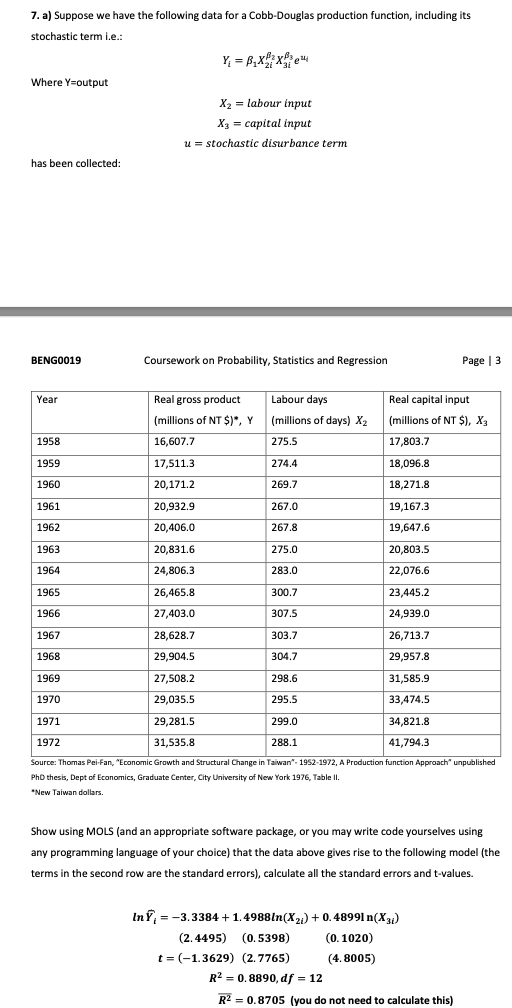7. a) Suppose we have the following data for a Cobb-Douglas production function, including its stochastic term i.e.: Where Ymoutput X2 = labour input X = capital input
7. a) Suppose we have the following data for a Cobb-Douglas production function, including its stochastic term i.e.: Where Ymoutput X2 = labour input X = capital input
MATLAB: An Introduction with Applications
6th Edition
ISBN:9781119256830
Author:Amos Gilat
Publisher:Amos Gilat
Chapter1: Starting With Matlab
Section: Chapter Questions
Problem 1P
Related questions
Question

Transcribed Image Text:b) Perform zero null hypotheses for each of the three parameters in the above model using a = 5%
and clearly state your deductions as well as the alternate hypotheses.
c) Determine 95% confidence intervals for the parameters of the model and c-".
your deductions
for part (b) above.
d) What is the p-value for each parameter with respect to a zero null hypothesis.

Transcribed Image Text:7. a) Suppose we have the following data for a Cobb-Douglas production function, including its
stochastic term i.e.:
Y, = B,x: xe
Where Y=output
X2 = labour input
Хз — саpital input
u = stochastic disurbance term
has been collected:
BENGO019
Coursework on Probability, Statistics and Regression
Page | 3
Year
Real gross product
Labour days
Real capital input
(millions of NT $)", Y (millions of days) X2
(millions of NT $), X3
1958
16,607.7
275.5
17,803.7
1959
17,511.3
274.4
18,096.8
1960
20,171.2
269.7
18,271.8
1961
20,932.9
267.0
19,167.3
1962
20,406.0
267.8
19,647.6
1963
20,831.6
275.0
20,803.5
1964
24,806.3
283.0
22,076.6
1965
26,465.8
300.7
23,445.2
1966
27,403.0
307.5
24,939.0
1967
28,628.7
303.7
26,713.7
1968
29,904.5
304.7
29,957.8
1969
27,508.2
298.6
31,585.9
1970
29,035.5
295.5
33,474.5
1971
29,281.5
299.0
34,821.8
1972
31,535.8
288.1
41,794.3
Source: Thomas Pei-Fan, "Economic Growth and Structural Change in Taiwan". 1952-1972, A Production function Approach" unpublished
PhD thesis, Dept of Economics, Graduate Center, City University of New York 1976, Table Il
*New Taiwan dollars.
Show using MOLS (and an appropriate software package, or you may write code yourselves using
any programming language of your choice) that the data above gives rise to the following model (the
terms in the second row are the standard errors), calculate all the standard errors and t-values.
InY, = -3.3384 +1.4988ln(X2) + 0.48991 n(X)
(2.4495) (0.5398)
(0. 1020)
t = (-1.3629) (2.7765)
R? = 0, 8890, df = 12
(4. 8005)
R2 = 0.8705 (you do not need to calculate this)
Expert Solution
This question has been solved!
Explore an expertly crafted, step-by-step solution for a thorough understanding of key concepts.
This is a popular solution!
Trending now
This is a popular solution!
Step by step
Solved in 3 steps with 1 images

Recommended textbooks for you

MATLAB: An Introduction with Applications
Statistics
ISBN:
9781119256830
Author:
Amos Gilat
Publisher:
John Wiley & Sons Inc

Probability and Statistics for Engineering and th…
Statistics
ISBN:
9781305251809
Author:
Jay L. Devore
Publisher:
Cengage Learning

Statistics for The Behavioral Sciences (MindTap C…
Statistics
ISBN:
9781305504912
Author:
Frederick J Gravetter, Larry B. Wallnau
Publisher:
Cengage Learning

MATLAB: An Introduction with Applications
Statistics
ISBN:
9781119256830
Author:
Amos Gilat
Publisher:
John Wiley & Sons Inc

Probability and Statistics for Engineering and th…
Statistics
ISBN:
9781305251809
Author:
Jay L. Devore
Publisher:
Cengage Learning

Statistics for The Behavioral Sciences (MindTap C…
Statistics
ISBN:
9781305504912
Author:
Frederick J Gravetter, Larry B. Wallnau
Publisher:
Cengage Learning

Elementary Statistics: Picturing the World (7th E…
Statistics
ISBN:
9780134683416
Author:
Ron Larson, Betsy Farber
Publisher:
PEARSON

The Basic Practice of Statistics
Statistics
ISBN:
9781319042578
Author:
David S. Moore, William I. Notz, Michael A. Fligner
Publisher:
W. H. Freeman

Introduction to the Practice of Statistics
Statistics
ISBN:
9781319013387
Author:
David S. Moore, George P. McCabe, Bruce A. Craig
Publisher:
W. H. Freeman